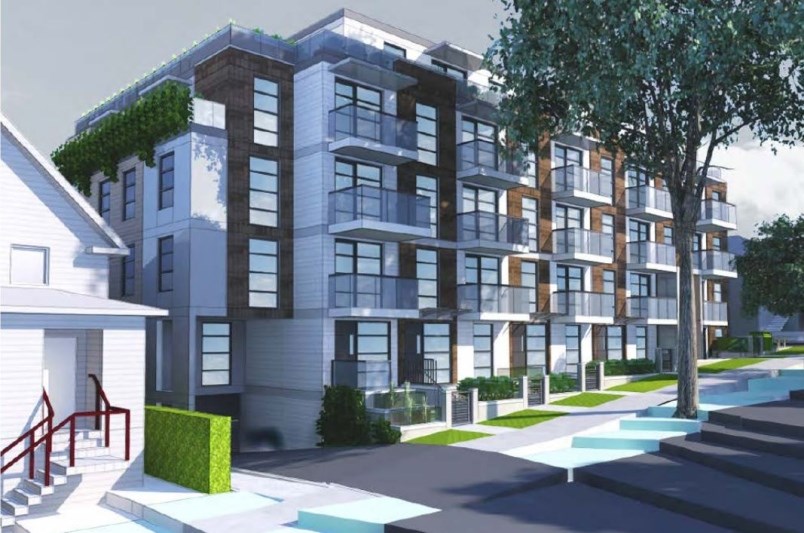The debate about whether a five-storey rental building should be built on Grant Street in Grandview-Woodland will likely be settled later this week if the Sept. 12 public hearing for the project wraps up quickly.
But council’s decision, like many ones about developments, will almost certainly be divisive.
Critics, including the Grandview Woodland Area Council (GWAC) and the Britannia Woodland Area Group, call the proposal a “blockbuster” while proponents argue the project — and other ones like it for purpose-built rental buildings — need support if the city is to mitigate the rental crisis.
The Grant Street proposal, submitted by Stuart Howard Architects on behalf of Britannia Ridge Developments, is in its fourth iteration and has been scaled down from six to five storeys, and from 38 to 35 rental units, in reaction to concerns from the public and feedback from the city’s Urban Design Panel. Several other changes, including to the façade, were also made to address concerns.
If approved, the building would be constructed on four single-family properties from 1535 to 1557 Grant St. Rents are anticipated to be affordable for households earning between $70,000 and $150,000 annually.
W. Neil Robertson of Stuart Howard Architects believes the building is compatible with what’s already in the neighbourhood, which include four-storey apartments within blocks of the site. He said the application meets requirements of the Grandview-Woodland Community Plan and has been thoroughly reviewed by the city’s engineering department to ensure the site will be accessible to emergency vehicles and other service vehicles.
“This is in keeping with what the plan envisioned for the neighbourhood going forward,” Robertson said, adding the proposal was also dialed back from the maximum allowable height and density specifically to address concerns over it being too big and too imposing.
Critics, however, aren’t satisfied with the changes. They maintain the site is inappropriate — the street is narrow and on a steep hill — the proposed rents aren’t affordable, fire and garbage trucks will have trouble getting to the property, and there’s not enough parking.
The site is located mid-block on Grant Street between Woodland and Cotton Drives and there isn’t a lane separating the homes on Grant Street from the homes to the north on Kitchener Street. The lots are also shorter than typical lots, so they’re closer to each other than they’d normally be.
Because of those reasons, Dorothy Barkley, a past president of GWAC, maintains the proposed building would “overwhelm” the character homes behind it.
“This is the wrong project for this location,” she said.
“In this neighbourhood, people largely believe that there should be the creation of affordable housing, it should be distributed across this city and not just in our neighbourhood, but it should also be site-specific. If you talk to any architect about any project, the first thing they’ll talk about is designing for the location...”
Barkley questions why the city would be “encouraging” the creation of a project that she says is not affordable and which will “undermine” an “established and well balanced” neighbourhood when it should be encouraging the preservation and restoration of existing affordable housing and multi-family residential homes with rental apartments.
Barkley worries the project will set a precedent and become the first in a series of such buildings. She maintains a lot of rental housing has already been approved or will be going up on sites such as Oakridge, Pearson-Dogwood and First and Clark.
“The city should focus on securing the tenure of existing co-op buildings whose leases are coming up,” she said. “Let’s not take down the existing affordable rentals but rather create rules and bylaws that incentivise the restoration and preservation of existing rentals.”
David Hutniak, executive director of LandlordBC, insists not nearly enough purpose-built rental has been approved in recent years, and the city is falling well short of its targets.
He said rental is needed for people at all levels of the economic scale, particularly since buying a home in Vancouver is prohibitive for most people — even for some in the higher income bracket. Most people moving into the city, he added, wind up renting for increasingly extended periods and the city has persistently low vacancy rates.
“We’ve hardly moved the needle on the vacancy rates and that’s at a time here now where we have [regulations] on Airbnb, we have the empty homes tax [and] we have the provincial speculation tax,” he said. “There are many who thought those three measures would create a flood of rental in the market that would drastically expand the pool and it hasn’t… How are we going to get out of this if we don’t build a ton of rental…?”
Meanwhile, when the Courier asked Robertson how he feels going into Thursday’s public hearing, he said:
“All that we can do is ensure that we do our due diligence and make sure that we’re in keeping with all council-approved guidelines, that we’ve listened to staff, we’ve listened to the UDP, and we’ve listened to the neighbourhood.
“Every step along the way, we’ve taken stock of what people have said and we’ve redesigned the project to address all the concerns that we were able to. In that respect, I believe we’ve been quite successful in working with all stakeholders to achieve something that is a compromise that will serve the neighbourhood for the next 60 years or the life of the building, whichever is longer.”
noconnor@vancourier.com
@naoibh



